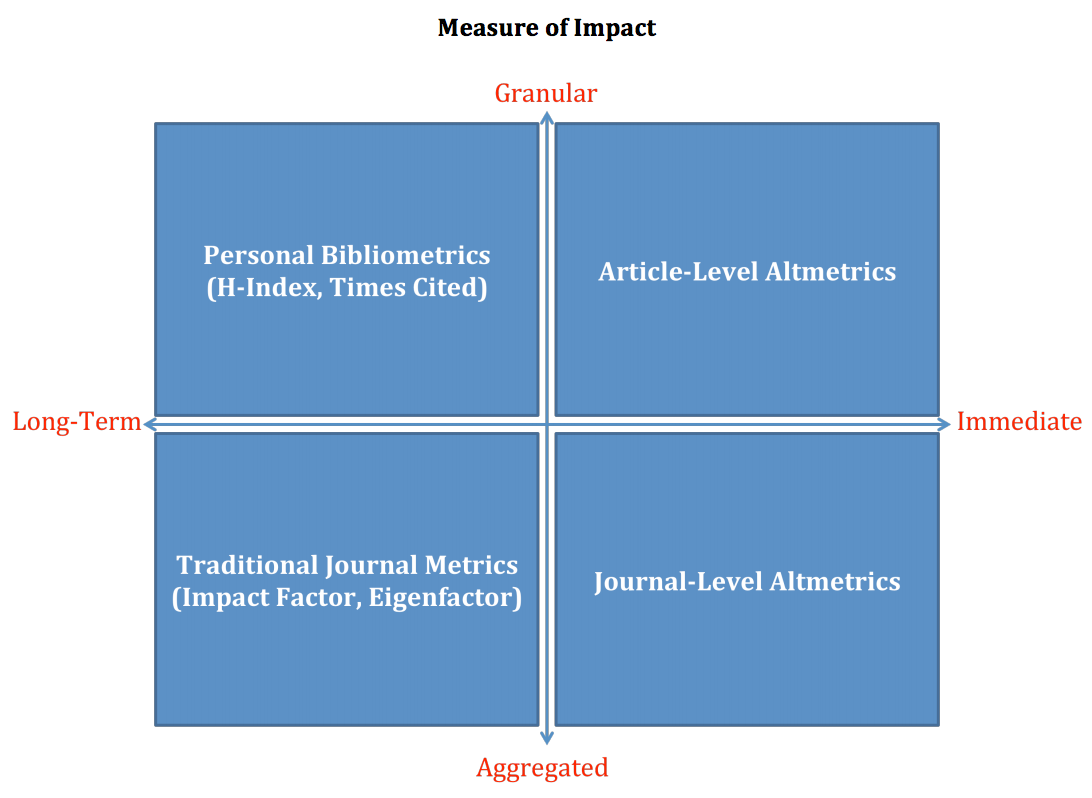What are Article-Level Metrics?
Article-Level Metrics (ALMs) are a new approach to quantifying the reach and impact of published research. Historically, impact has been measured at the journal level. A journal’s average number of citations to recent articles (i.e., its impact factor) has for years served as a proxy for that publication’s importance. Articles published in highly-cited journals were viewed as impactful by association. As electronic dissemination of scholarly content has surpassed print, it has become easier to disaggregate an individual article’s impact from the publication in which it appeared. It’s also possible to track different markers of an article’s reach, beyond just citations. ALMs seek to incorporate new data sources (sometimes referred to as “altmetrics”) along with traditional measures to present a richer picture of how an individual article is being discussed, shared, and used.
Article-Level Metrics are not simply an alternative way to measure impact; they are a toolkit of heterogeneous data points that can be mixed and matched as circumstances warrant. These data points enhance our ability to measure a wide variety of ways in which research may be reaching and affecting its audience, both within and beyond the scholarly community.
In a paper-based world, citation counts were the easiest way to quantify an article’s consequence. Tracking how a paper was used – and who was using it – was simply not possible. It was difficult to measure how quickly a new research concept or theory took hold within the scientific community. Article-Level Metrics open the door to measures of both the immediacy and the socialization of an article. These are critical components of impact that have not previously been captured.
Article-Level Metrics: A SPARC Primer
SPARC believes that ALMs have the potential to help transform the reserach evaluation process, and has produced a guide to understanding the basics of Article-Level Metrics that explores the definition, application, opportunities and challenges presented by ALMs. This primer also delves into the connection of ALM’s to the Open Access environment, and their potential application in the research evaluation and tenure and promotion processes.
Click here to download SPARC’s ALM Primer.
Other Resources on Article-Level Metrics
The Public Library of Science (PLoS) was the originator of Article-Level Metrics, and provides a robust set of resources and tools to facilitate the understanding and application of ALMs: http://article-level-metrics.plos.org
“Altmetrics” vs. Article-Level Metrics
As adoption of Article-Level Metrics has increased, the term “Altmetrics” is sometimes used interchangeably with ALMs. It’s important to distinguish between two similar – but not synonymous – terms. ALMs are an attempt to measure impact at the article level. In doing so, ALMs draw from a variety of different data sources, some traditional (e.g., times cited) and some new (e.g., tweets). The attempt to incorporate new data sources to measure the impact of something, whether that something is an article or a journal or an individual scholar, is what defines altmetrics. Altmetrics are about the data sources, not the level of aggregation. ALMs are about the incorporation of altmetrics and traditional data points to define impact at the article level.
Resources on Altmetrics
ImpactStory is an open-source, web-based tool that provides open metrics, with context, to help researchers explore and share the diverse impacts of all their research products — traditional ones like journal articles, but also alternative products like blog posts, datasets, and software: http://impactstory.org/faq
Altmetric.com is a commercial venture that provides a suite of tools to researchers, authors and publishers to understand and apply open metrics to articles and collections of articles: http://www.altmetric.com/index.php
